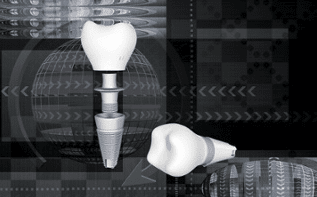 Dental implants have a very high success rate – about 95 percent overall, according to American Association of Oral and Maxillofacial Surgeons (AAOMS) figures – but failures do occur from time-to-time. Most frequently, those failures happen within the first few weeks of placement, but in some cases, implants can loosen and fail several years later. The bottom line is that any movement, loosening or pain around an implant is cause for concern and should be evaluated by your oral surgeon, whether that implant has been in place for a month or year. So what can be done about a loose dental implant?
Dental implants have a very high success rate – about 95 percent overall, according to American Association of Oral and Maxillofacial Surgeons (AAOMS) figures – but failures do occur from time-to-time. Most frequently, those failures happen within the first few weeks of placement, but in some cases, implants can loosen and fail several years later. The bottom line is that any movement, loosening or pain around an implant is cause for concern and should be evaluated by your oral surgeon, whether that implant has been in place for a month or year. So what can be done about a loose dental implant?
About Loose Dental Implants
When dental implants are loose early on, the problem is typically related to poor osseointegration – or bonding – with the jawbone. Failure to fuse properly with the jawbone can be caused by a number of factors, including poor implant placement, infection, poor bone quality or quantity, overloading, undue pressure on healing implants, smoking or certain health issues, like uncontrolled diabetes or hypertension, among others.
Dental implants that loosen months or years after successful placement may be affected by factors that include an infection called peri-implantitis, a form of gum disease that affects dental implants and can cause inflammation and bone loss. Patients with the highest risk of peri-implantitis include smokers, diabetes sufferers, those with thin gums and individuals who are not as diligent as they should be in terms of oral hygiene. Other factors that can cause or contribute to late dental implant failures are bruxism – or chronic teeth grinding or clenching – loose or poorly made crowns or abutments, and health issues that affect bone strength and density.
Treating Loose Dental Implants
The first step in treating a dental implant that seems loose, with detectable movement, is to make an appointment with an oral and maxillofacial surgeon for a thorough examination to determine whether the issue lies with the implant itself, or can be attributed to loosening in or damage to prosthetic teeth. To diagnose the exact cause of the issue, your oral surgeon will perform a physical examination of the implant site and surrounding areas, looking for inflammation, redness or bleeding of gum tissues that can indicate infection and evaluating the condition of the implant, prosthetics and abutments. Imaging will also be done to look for signs of infection, bone loss or other problems around your implant.
While many infections and other issues can be treated successfully when caught early, saving the implant, implants that have become loose and unstable often require dental implant revision surgery, which is the removal of a failed or ailing dental implant. In many cases, a new implant can be placed, either immediately or after bone augmentation is completed to provide a more stable foundation for implant-based restorations. Of course, that depends upon your particular circumstances in terms of general health, oral health and the existing damage to the implant site – factors that your oral surgeon will evaluate and discuss with you as your treatment plan is formulated.

Schedule an appointment with one of our oral surgeon by calling our office at (202) 386-7100.